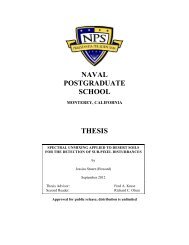October 2000 Newsletter - Naval Postgraduate School
October 2000 Newsletter - Naval Postgraduate School
October 2000 Newsletter - Naval Postgraduate School
You also want an ePaper? Increase the reach of your titles
YUMPU automatically turns print PDFs into web optimized ePapers that Google loves.
MICRO-AIR VEHICLE AERODYNAMICS, continued from page 42<br />
shown in Figure 4.<br />
Since the resultant force must be normal to the incident<br />
flow, the resultant force vector must be tilted forward, as<br />
shown in Figure 4, which provides both a lift component and<br />
a thrust component. Knoller and Betz went one step further,<br />
and they noted that if the wing was flapped (plunging it up<br />
and down vertically in an oscillatory fashion) while the lift<br />
force would be both positive and negative during the cycle,<br />
averaging to zero, the thrust force would always be<br />
non-negative, so the average thrust would be a<br />
positive value. (For an animated demonstration of<br />
this phenomenon, visit our online version of this<br />
article at www.aa.nps.navy.mil/~jones/research/<br />
unsteady/propulsion/theory/).<br />
Prandtl’s student Birnbaum (1924) first presented a<br />
solution for incompressible flow past flapping airfoils,<br />
while Katzmayr (1922) in Vienna produced the first<br />
wind tunnel measurements which conclusively showed that<br />
an airfoil mounted in an oscillating wind stream experiences a<br />
thrust force. In the 1940’s and 50’s Schmidt (1965) in East<br />
Germany started to conduct systematic experiments on<br />
flapping foil propellers which led him to the development of<br />
the wave propeller and its demonstration on a catamaran<br />
boat. Classical oscillatory thin airfoil theory shows that the<br />
propulsive efficiency of a single harmonically plunging airfoil<br />
is only about 50 percent unless the airfoil oscillates rather<br />
slowly (which in turn requires a large airfoil in order to obtain<br />
Figure 5. Thrust Indicative Vortex Street.<br />
FEATURED PROJECT<br />
Figure 4. Induced velocity<br />
and the resultant<br />
tilting of the normal-force<br />
vector.<br />
significant thrust values). Schmidt sought to overcome this<br />
deficiency by arranging two airfoils in tandem, where the<br />
forward foil is oscillating and the rear-ward foil is stationary.<br />
This makes it possible to convert the vortical energy generated<br />
by the forward foil into additional thrust rather than being<br />
wasted. Schmidt claimed that his wave propeller achieved<br />
efficiencies comparable to those of conventional propellers<br />
and had the additional advantage of enabling operation in<br />
shallow waters.<br />
Flapping Wings Generate Vortices<br />
It is a well known fact that a vortex is generated<br />
whenever an airfoil changes its angle of attack.<br />
Therefore, a flapping airfoil continuously sheds<br />
vortices from its trailing edge. We have made extensive<br />
studies of this vortex shedding phenomenon. Two<br />
examples are shown in Figures 5 and 6, where the<br />
lower image is a photograph of the water-tunnel<br />
experiment, and the upper image is a schematic<br />
representation of the vortices. If one measures the<br />
time-average of the flow at some station downstream<br />
of the trailing edge (as we did using the previously<br />
described LDV instrumentation), one obtains the jetlike<br />
distribution schematically shown in the upper<br />
part of Figure 5. Hence the flapping wing generates a<br />
jet similar to the jet produced by a conventional<br />
propeller or jet engine.<br />
It is interesting to note, however, that when we flap<br />
--continued on page 44<br />
NPS Research page 43<br />
<strong>October</strong> <strong>2000</strong>
















